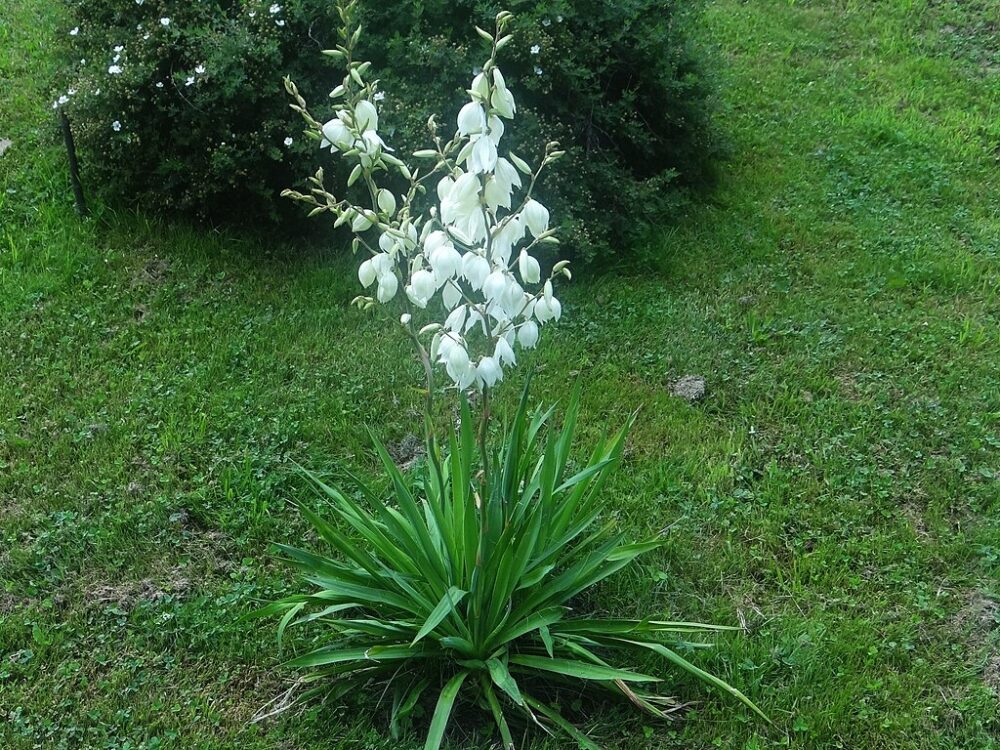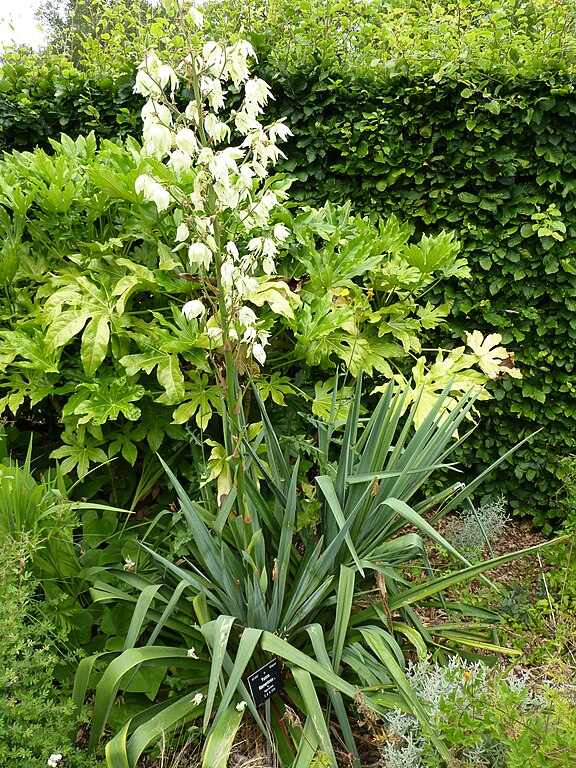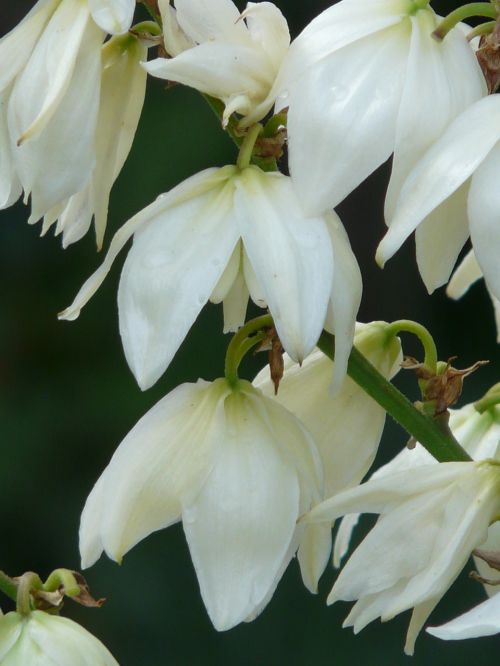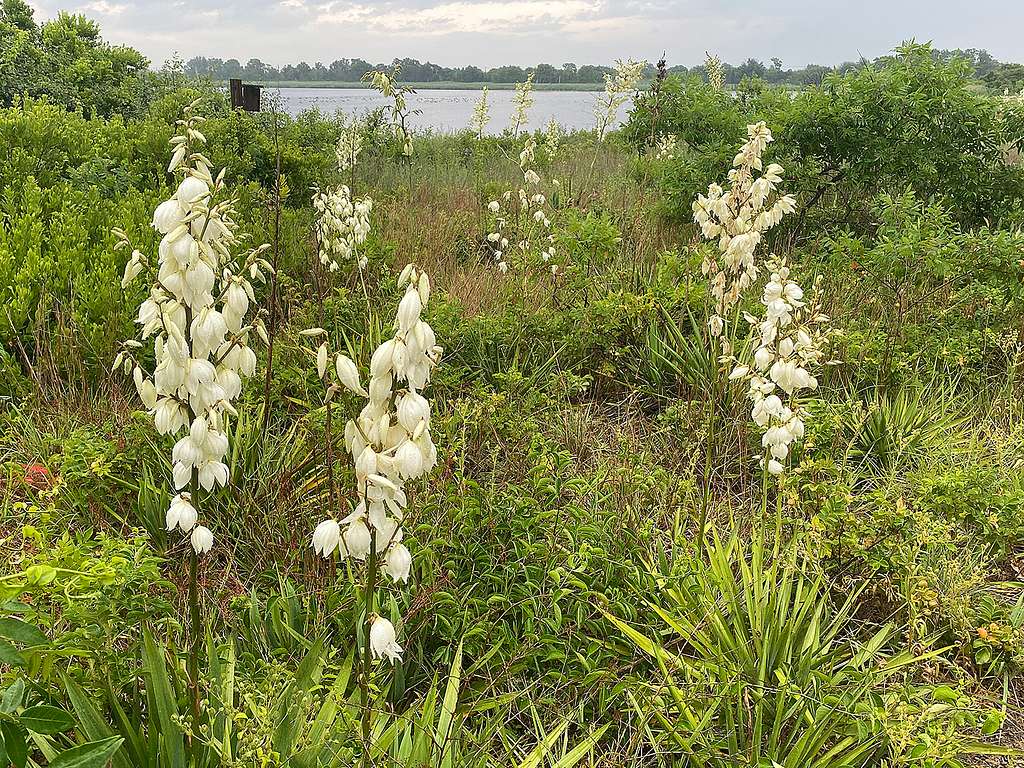Adam's needle (Yucca filamentosa) is a slow-growing evergreen shrub commonly used in Southwest landscaping. Closely related to many cacti and succulents, it is a yucca plant in the asparagus family that looks more like a perennial than a shrub. The plant's flowers, fruits, seeds and stalks are all edible.
Read on to find out about this plant’s many versatile uses.
Yucca Filamentosa Plant Profile
| Scientific name | Yucca filamentosa |
| Family | Asparagaceae (asparagus family) or Agavaceae |
| Plant type | Shrub, rhizome |
| Kingdom | Plantae |
| Genus | Yucca |
| Order | Asparagales |
| Phylum | Vascular plant |
Common names include:
- common yucca
- Adam’s needle yucca
- Spanish bayonet
- yucca
- needle palm
Adam’s needle is a species of flowering plant in the family Asparagaceae that is native to the southeastern United States. An evergreen shrub with a height of 8 feet, it is valued for its architectural qualities in horticulture.
What Are You Foraging For Right Now?
We're thrilled to hear your ideas. What would you like to submit today? Feel free to share your thoughts and experiences with us.
The mature plants, about four or five years old, will send up flower stalks from the center of the foliage in late spring or summer, which can double the height of this yucca plant. Nodding, white bells appear on the blooms.
Late in spring, a flowering stalk rises from the center of each rosette, typically reaching 5-8 feet in height but rarely reaching 12 feet, bearing long panicles of white, showy bell-shaped flowers.
The fruits are elliptical dehiscent capsules. Over time, basal offsets will form a small colony.



Why Is It Called Adam’s Needle?
Adam’s needle gets its name from its long, sword-like foliage with sharp needle-like tips.
It appears that these straps of foliage are peeling away from each other as they are covered with tiny thread-like filaments around their edges.
Where Does Adam’s Needle Grow?
The yucca is a native plant of North America. In its native range, which extends from the beaches and sand dunes of South and North Carolina, south to Florida and Mississippi, the plant has escaped cultivation and is now found in New England, where it has expanded its range north.
You can plant Yucca filamentosa in USDA hardiness zones 5 to 10, where it is very adaptable to all climate variations within those zones.
Where to Forage for Adam’s Needle?
In the wild, you can find Adam’s Needle in a variety of habitats, including:
- Coastal Dunes: Adam’s Needle is well-suited to sandy coastal soils, and it is often found in dune ecosystems along the Atlantic coast.
- Dry, Sandy Soils: This yucca species thrives in well-drained and sandy soils. It can tolerate drought conditions and is well-adapted to arid landscapes.
- Open Woodlands: While it can be found in more open areas, Adam’s Needle is also found open woodlands and scrublands.
- Roadsides and Disturbed Areas: It is not uncommon to find Adam’s Needle along roadsides and in disturbed areas, showcasing its ability to colonize a variety of environments.
When to Forage for Adam’s Needle?
Spring to Early Summer: The best time to forage for Adam’s Needle is in the spring to early summer when the plant is in active growth. This is when the leaves are more tender and suitable for various uses.
Blooming Season: Adam’s Needle typically blooms in late spring to early summer. During this time, it produces tall flower spikes adorned with creamy-white flowers. While the flowers are not the primary foraged part, the blooming season can help with plant identification.
What Is Adam’s Needle Used For?
The Adam’s needle is one of the most useful plants to know for wilderness survival. It is edible, medicinal, and has been used for the following purposes:
- Ornamental Planting: One of the primary uses of Adam’s needle is as an ornamental plant in landscaping and gardens. Its striking, sword-like leaves and tall flower spikes make it a popular choice for adding architectural interest to gardens.
- Medicinal Uses: Some Native American tribes historically used yucca plants for various medicinal purposes. The roots were believed to have anti-inflammatory properties and were used to treat conditions such as arthritis.
- Soap and Shampoo: The roots of yucca plants, including Adam’s needle, contain natural saponins, which can be used to produce soap and shampoo. The saponins have cleansing properties that create a lathering effect when mixed with water.
- Fiber Production: The fibers extracted from the leaves of Yucca filamentosa have been historically used by indigenous peoples for making cordage, baskets, and textiles. The fibers are strong and durable.
- Culinary Uses: While not as common, certain parts of the yucca plant, including the flower petals and young shoots, are edible. However, it’s crucial to be cautious, as other parts of the plant can be mildly toxic.
Make sure to check out our video for 5 more plants to forage for better sleep.
Is Adam’s Needle Poisonous?
While Adam’s needle is not considered highly toxic, it’s important to note that certain parts of the plant can be mildly toxic if ingested.
The primary concern lies in the plant’s saponins, which are naturally occurring compounds found in various plant species, including yuccas.
If you have pets, be aware that they may experience mild gastrointestinal upset if they ingest parts of the plant.

What Parts of Adam’s Needle Are Edible?
Here are the edible parts of yucca:
- Flower Petals: The petals of the yucca flowers are edible and can be consumed raw or cooked. They are sometimes used in salads or as a garnish. The flavor can vary among species, but they generally have a mild, slightly sweet taste.
- Young Shoots: The tender, young shoots or leaf bases of some yucca species are edible. These can be cooked and eaten similar to asparagus. Harvesting shoots from the outer parts of the plant is typically preferable, as they tend to be more tender.
- Fruits: The fruits of certain yucca species are also edible. These fruits are usually fleshy and can be eaten raw or cooked. They may have a sweet or starchy taste, depending on the species.

If you’d like to try some other wild edibles that are perfect for salads or as garnishes, check out:
How to Eat Yucca/Adam’s Needle?
Here’s how I prepare and eat yucca:
Ingredients:
- Yucca root
- Water
- Salt (optional)
Steps:
- Selecting Yucca:
- Choose fresh yucca roots that are firm and have smooth, unblemished skin. Avoid roots with soft spots or signs of decay.
- Peeling:
- Wash the yucca thoroughly under running water to remove any dirt. Using a sharp knife, trim both ends of the yucca root. Stand the yucca upright and carefully cut away the tough outer skin in strips, following the contour of the root.
- Cutting:
- Once peeled, cut the yucca into manageable pieces, typically 2 to 3 inches in length. You can further cut these pieces into sticks or chunks, depending on your preference.
- Boiling:
- Place the yucca pieces in a pot of salted boiling water. Boil until the yucca is tender, which usually takes about 15 to 20 minutes. You can check for doneness by inserting a fork into a piece; it should pierce easily.
- Draining:
- Once the yucca is cooked, drain it in a colander to remove excess water.
- Optional: Frying (Cassava Fries):
- For a different texture, you can fry the boiled yucca pieces. Heat oil in a pan and fry the yucca until golden brown. This method is popular for making cassava fries.
- Serving:
- Serve the boiled or fried yucca as a side dish or incorporate it into various recipes. Yucca pairs well with different sauces, dips, or seasonings.
Additional Tips:
- Cassava Flour: Yucca can also be processed into cassava flour, a gluten-free alternative to wheat flour. This flour is used in baking and cooking, similar to other grain flours.
- Boiled Yucca:
- Serve boiled yucca as a side dish with sauces like chimichurri, garlic sauce, or aioli.
- You can include boiled yucca in soups or stews.
- Fried Yucca:
- Sprinkle salt, paprika, or your favorite seasoning on fried yucca for added flavor.
- Serve cassava fries with dipping sauces like ketchup or mayonnaise.
Ana has always been interested in all things nature and flora. With her expertise in home gardening and interest in foraging, she has been spending her weekends and free time looking for edible native plants, flowers, and fungi. One of her many hobbies includes testing new savory and sweet recipes, juices or teas made from freshly picked plants, wild fruits, or mushrooms.

